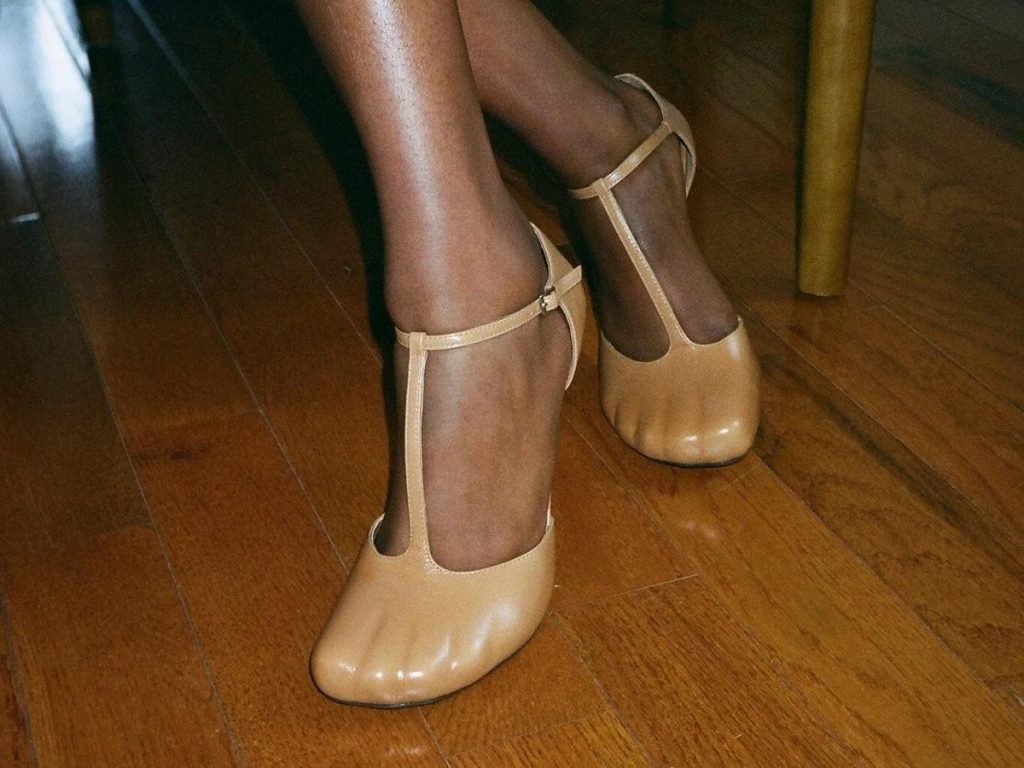A staple within the wardrobes of early 20th century women and on-stage performers, the T-strap shoe has returned to modern fashion as the dominating style of the season—with it’s comfortable silhouette, detailed structure and classic design drawing in a multi-generational audience eager to get their hands on the traditional footwear option reimagined for a contemporary consumer.
The T-Strap: A History
With a history that stretches across numerous trend cycles, the T-strap shoe has historically functioned as a silhouette worn for practicality over design. From 1920s flappers to modern-day stage performers, the innovative T-strap detail—which typically connects vertically from the shoe’s toebox to a supportive ankle strap—offers a comfortability and secure fit ideal for dancing, light running or galavanting across stage.
As streetwear—the medium in which the silhouette was most popular throughout the 1960s—the shoe provided a sense of playfulness and whimsy to the ensemble it was paired with. Detailed with a short box heel and small buckle fastening, the T-strap shoe was often worn with a micro mini skirt—a pairing which, working in tandem with the shoe’s upright detailing, worked to elongate the wearer’s leg line and add a flirty, youthful elegance to one’s look.
The Modern T-Strap
Presently, piggybacking off the popularity of last season’s most dominant shoe silhouettes—think slingbacks, strap-adorned ballet flats and Mary Janes—innovative takes on the T-strap design have been shown by both high-end on affordable brands alike.
From Jeffrey Campbell’s Conform-T stiletto pumps—designed with an illusionary embossed toe detail that tricks the eye into believing the shoe has been shrinkwrapped onto the wearer’s foot—to Old Navy’s minimalistic Mary Jane T-strap flats—completed with a pointed toe and embossed croc faux-leather—the trend has proven to be increasingly versatile and even beneficial, with the allowance of subtle tweaks in the silhouette’s simple design aiding respective brands in better targeting their specific consumer base.
However, in addition to detailing the market’s current T-strap saturation, a pending question still requires analysis: why now?
Gen Z and The Practical Consumer
To provide additional insight on why the T-strap shoe might be gaining popularity this season, Hazel Clark, professor of design studies and fashion studies at Parson’s School of Design, weighed in on the conversation.
“I wonder if—this season—it might also be a question of practicality and elegance,” she said. “The T-bar stays on the foot—and is more elegant than the Mary Jane’s which have been worn recently. The current T-bars are also quite elegant and elongated in their style—so quite a ‘grown up’ version—not to be associated with children’s shoes.
“So—why now—practical but also more elegant—and following the popularity of pumps and Mary Janes—a more sophisticated variation on both themes perhaps?”
Despite Clark presenting her reasoning for the silhouette’s rapid growth as merely a hypothesis, a 2024 report from Boston Consulting Group titled, “How Can US Brands Reach Gen Z?,” supports her claim that Gen Z’s desire for practicality and maturity might be the root cause of the T-strap’s recent popularity.
In the report, the firm cited a original survey conducted with 6,000 consumers, interviews with 400 respondents and extensive analysis of social media to reveal characteristics about Gen Z’s spending habits, unveiling that “Gen-Zers are also seeking items that they truly want, that speak to their lives, or that support their overall enjoyment. And they don’t want to make tradeoffs.”
Utilitarian silhouettes like the T-strap shoe is just one example of the plethora of newly emerging clothing and accessory trends appearing in an effort to appease Gen Z consumers—a generation who, especially as they grow older and begin to establish buying habits that will take the through adulthood, increasingly crave items that offer practicality and versatility offline. Similar trends favored by the freshly-turned twenty-somethings include large shoulder bags for maximal storage, an emphasis on quality knitwear for longevity and wide-legged pants for comfortability.
With a generation inspired by functionality, Gen Z doesn’t care that the T-strap is old-fashioned—it simply works.
The report goes on to amplify this, citing the generation’s open-mindedness as it’s most appealing quality, saying, “There is much that brands both large and small can do to capture and win Gen Z consumers. The effort does not require the biggest budget or a massive transformation. Instead, tactical changes and experimentation can move a brand closer to becoming the purchase of choice for today’s Gen Z shoppers.”

